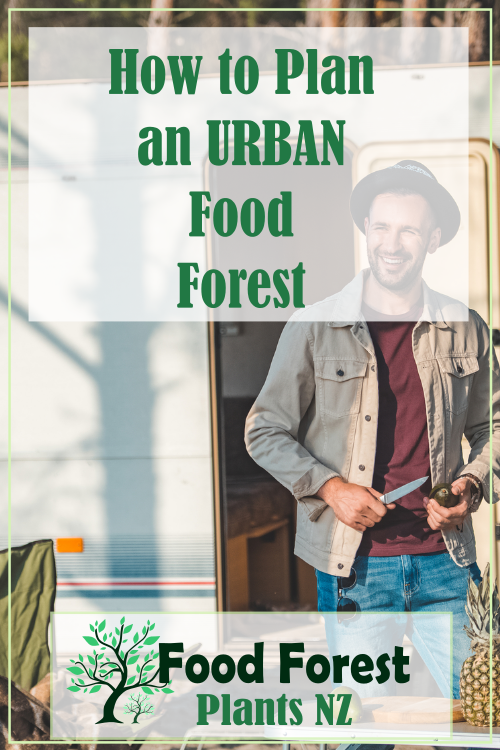A food forest can be as simple as a couple of fruit trees and some understory plants in an urban backyard, or as complex as a 1000 acre forest.
Planning a food forest, no matter how big, has a few steps that are worth following and working your way through. Planning your urban food forest well at the beginning can save you some real heartache and extra work in the long term.
Please read: This information is provided for educational purposes only.
This post may contain affiliate links, this means at no extra cost to you, we make a commission from sales. Please read our Disclosure Statement
Step by step guide to planning a new Edible Food Forest Garden in the City
Work your way through these 5 steps to ensure that your urban edible food forest garden ends up the way you planned it to be.
Step One: Choose your urban site
If you don’t already own a section, now is the time to work out exactly what you want from the land.
If you already have land, you need to decide where on the site is the best spot for a food forest.
Things to consider in both circumstances are:
- Rain fall: How much rain do you get in a year, is it enough to sustain a food forest garden?
- Water management: Along with rain fall, are there other water features or issues? A steep slope will often dry out, while heavy rain will wash away any bare topsoil. A flat site is at risk of becoming boggy or even flooding. Does your site have ponds, swales, dry ridges, streams or boggy areas.
- Land shape: The steepness of your land not only affects water-fall but also site access and usability. Presumably with a food forest, you will want to be able to access the food regularly, so adding paths, and choosing an area that is not too steep would be useful. Do you need to add any water management earthworks before starting to plant? Now is the time to plan for swales (not recommended in areas of high water fall), keyline plowing, or pocket ponds.
- The sun: Most plants benefit from sun, a north facing section, with a slight downward slope to the north would be perfect. Watch and see where the sun goes through the course of the day, are there any big trees that need removed first?
- The wind: Wind can be devastating to young trees. Work out your prevailing wind/s and work out what you are going to do to block them. Planting wind breaks or using windbreak fencing are both good options.
- The soil: Before pouring your heart, soul, time, effort and money in to developing a food forest space, it is a really good idea to inspect your soil and work to improve it. More on checking and improving soil quality here.
Step Two: Plan your overall food forest layout
Get a map of your property that is to scale – you can usually print these off of your council website, or use the satellite view in Google maps.
Take measurements of your site and mark them on.
Mark the sun and wind directions, and any water related points and your house/other buildings on the map. Think long and hard about what earthworks would be useful before planting begins.
Plan where your windbreaks will go.
Step Three: Choose your plants
There are so many beneficial food forest plants that you could use. Usually you plant perennial plants, and medicinal plants as well as a selection of fruit trees, as well as nitrogen fixers, mulch producing ‘chop and drop’ plants and flowers to bring in the beneficial insects.
Generally, if you are starting your food forest in the city or on a smaller urban plot, you will want your biggest trees to be fruit trees, and if your yard is smaller, dwarf fruit trees might be better suited to your situation.
A food forest has many layers, making the best use of the vertical space for growing. The layers include trees in the canopy, shrubs, bushes, vines, herbs, ground covers and root crops, and can also include edible fungi! Read here for more on the layers of a food forest.
In an urban setting think about planting up fences, container gardens and espalier fruit trees against fences. Pergolas can support fruiting vines, and hedges can be replaced with fruiting varieties.
Step Four: Prep your backyard
Get in a digger, or manually change the shape of the land if required. Now is the time to make a mess and rearrange things.
Plant your windbreak, and start looking for ways to clear off the weeds and grass that currently cover the ground. You may choose to remove sod with a sod cutter, or cover the ground for 3-12 months with tarps/something that blocks the light.
Other options include spraying the weeds or tilling them in, both of which are controversial, and have both benefits and downsides. You could use intensive pigs or chickens to clear the site and loosen the soil for you if you are allowed them where you live.
Step Five: Plant out your urban food forest
Planting in a food forest is pretty much an ongoing thing, but get your framework trees in first and go from there.
Plant your support species and cover any bare ground with mulch and/or cover crops.
To grow well, forests need a fungal dominant soil, so covering in compost and wood mulch will help encourage the beneficial fungi to grow much faster than leaving the ground to develop on its own.
For a more indepth guide see here


